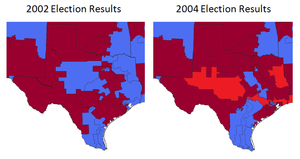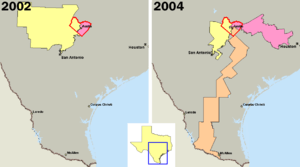2003 Texas redistricting

The 2003 Texas redistricting refers to a controversial mid-decade congressional redistricting plan. In the 2004 elections, it resulted in the Republicans taking a majority of Texas's House seats for the first time since Reconstruction. Opponents challenged the plan in three suits, combined when the case went to the United States Supreme Court in League of United Latin American Citizens v. Perry.
On June 28, 2006, the Supreme Court upheld the statewide redistricting as constitutional, with the exception of Texas' 23rd congressional district, which it held was racially gerrymandered in violation of Section 2 of the 1965 Voting Rights Act, apparently to try to protect a Hispanic Republican representative. A three-judge Federal District Court redrew District 23 and four other nearby districts: 15, 21, 25, and 28. In November 2006, a special election was held in the new districts, with all incumbents winning except in District 23. There, Republican incumbent Henry Bonilla was forced into a December run-off which he lost to Democratic challenger Ciro Rodriguez.
Overview
After Republicans won control of the Texas state legislature in 2002 for the first time in 130 years, they intended to work toward establishing a majority of House of Representatives seats from Texas held by their party. After the 2002 election, Democrats had a 17–15 edge in House seats representing Texas, although the state's voters voted for Republicans in congressional races by a 55–45 margin.[1] After a protracted partisan struggle, the legislature enacted a new congressional districting map, Plan 1374C, introduced in the Texas House by Representative Phil King of Weatherford. In the 2004 congressional elections, Republicans won 21 seats to the Democrats' 11.[2]
On June 28, 2006, the Supreme Court of the United States issued an opinion that threw out one of the districts in the plan as a violation of the 1965 Voting Rights Act and ordered the lower court to produce a remedial plan, which it did in Plan 1440C. The Supreme Court ruling was not seen as seriously threatening Republican gains from the 2004 elections.[3]
1991–2003 evolution and Tom DeLay's role
The time previous to 2003 when the Texas Legislature had enacted a Congressional redistrict plan was 1991, when Democrats held both the governor's seat (with Ann Richards) and control of both legislative branches. By the 2000 census, Republicans had recaptured the state executive branch, with Governor George W. Bush and Lt. Governor Rick Perry, as well as control of the Texas Senate. Democrats maintained their majority in the Texas House of Representatives.
In 2001, Democrats and Republicans were unable to agree on new district maps to correspond with the latest census. The Republican minority recommended the issue be submitted to a panel of judges, per state law. The judges, being "hesitant to undo the work of one political party for the benefit of another",[4] drew a new map which left much of the 1991 districts intact, and yielded a 17 to 15 Democratic majority US House delegation after the 2002 elections.
For Texas House and Senate redistricting, the Texas Constitution provides that the Legislative Redistricting Board (LRB) convenes when the state legislature is unable to approve, for either body, a redistricting plan in the first legislative session following the National Census. In June 2001, the task of redistricting passed to the LRB after the state legislature failed to pass a redistricting plan either for the House or Senate.[5] The LRB consists of five statewide officials, the Lieutenant Governor, the Speaker of the House, the Attorney General, the State Comptroller, and the Commissioner of the General Land Office. Four of these five officials were Republican and the resulting redistricting plans were seen as favorable to the Republicans.
In September 2001, then House Majority Whip Tom DeLay (TX-22) organized Texans for a Republican Majority (TRMPAC), a political action committee designed to gather campaign funds for Republican candidates throughout Texas—in particular with an eye to gaining control of the House Speakership, then held by Democrat Pete Laney. TRMPAC was modeled closely after DeLay's Americans for a Republican Majority (ARMPAC), a federal-level organization created to raise funds for Republicans during the 2000 national elections.[6] Simultaneously, as has been well documented in the media, DeLay played a key role in the ongoing Texas redistricting effort. In 2002, after winning a majority of seats in the State House of Representatives, Republicans gained complete control of the legislature. With the urging of Governor Rick Perry and Tom Delay, who had assumed the position of US House Majority Leader in January 2003, the Republican majority introduced legislation to redraw the court-drawn districts from 2001.
Lacking the sufficient votes to stop the new plan, 52 Democratic members fled the state to prevent a quorum in the Texas House, effectively preventing a vote from taking place during the regular session. The 52 Democrats became known as the "Killer Ds", and returned to the state when time had expired for the bill. However, in the summer of 2003, Governor Rick Perry called a series of special legislative sessions in order to continue the redistricting effort. With control of more than one third of the seats in the State Senate, the Democrats invoked a two-thirds rule, preventing a vote on the redistricting plan during the first special session. A half an hour after ending the first special session Governor Perry called a second special session. This time, due to the calendaring of the redistricting bill, the two-thirds rule would not come into play, leading to eleven of the twelve Democratic Senators fleeing the state to prevent a quorum. The Senators assembled in Albuquerque, New Mexico and were referred to as the Texas Eleven. After a month-long stand off, Senator John Whitmire returned to the State Senate, and the redistricting plan was passed in a third special legislative session. After the 2004 elections, Texas' U.S. House delegation had a Republican majority for the first time since Reconstruction, 21-11.
An article in the March 6, 2006, issue of The New Yorker magazine, written by Jeffrey Toobin, quoted Texas's junior Republican Senator John Cornyn as saying, "Everybody who knows Tom knows that he's a fighter and a competitor, and he saw an opportunity to help the Republicans stay in power in Washington." Toobin also noted that DeLay left Washington and returned to Texas to oversee the project while final voting was underway in the state legislature, and that "several times during the long days of negotiating sessions, DeLay personally shuttled proposed maps among House and Senate offices in Austin."[7] Texas Monthly editor Paul Burka, writing in the magazine's May 2006 issue, characterized the measure as "DeLay's midcensus congressional redistricting plan" and said, "[I]n order to increase his Republican majority in Congress, he [DeLay] resorted to a midcensus redistricting plan."
Justice Department involvement

At the time of the 2003 redistricting, Texas was under the pre-clearance requirements of Section 5 of the Voting Rights Act. The State of Texas obtained pre-clearance from the US Department of Justice for its 2003 Congressional redistricting plan.
However, in December 2005, The Washington Post reported, "Justice Department lawyers concluded that the landmark Texas congressional redistricting plan spearheaded by Rep. Tom DeLay violated the Voting Rights Act, according to a previously undisclosed memo," uncovered by the newspaper.[8] The document, endorsed by six Justice Department attorneys, said:"[T]he redistricting plan illegally diluted black and Hispanic voting power in two congressional districts ... The State of Texas has not met its burden in showing that the proposed congressional redistricting plan does not have a discriminatory effect."[8] In addition, according to the Post, Justice Department lawyers "found that Republican lawmakers and state officials who helped craft the proposal were aware it posed a high risk of being ruled discriminatory compared with other options". Further, Texas legislators proceeded with the new plan "because it would maximize the number of Republican federal lawmakers in the state".[8]
The article noted the position taken by the Civil Rights Division's staff lawyers and analysts had been overruled by senior political appointees in the Justice Department.[8]
Criticism of the plan
Democrats criticized the 2003 redistricting plan, citing the lack of precedent for redistricting twice in a decade (a so-called "mid-decade" redistricting) and argued that it was being done for purely political gain. Public comments by some Republicans lent support to this latter claim, since many discussed their expectations of picking up several Republican seats. Some minority groups argued the plan was unconstitutional, as it would dilute their influence and possibly violate the "one-person-one-vote" principle of redistricting. Republicans argued that, since most voters in the state were Republicans, it was appropriate that the party have a majority of the Congressional delegation in Washington.
The 2004 elections under the new redistricting resulted in Texas Republicans gaining a majority of House seats by a 21–11 margin, nearly a 2/1 ratio in terms of seats (66% of seats). This was larger than the 61/38 voting ratio of Republican to Democratic voting in the Presidential race. It was more lopsided that the total results in the 32 House races, which resulted in 56/40/3 for Republican to Democratic voting (the two main parties did not both run candidates in four districts).[9]
2006 Supreme Court review
The US Supreme Court issued an opinion on the case in League of United Latin American Citizens v. Perry on June 28, 2006. While the Court said states are free to redistrict as often as desired, the justices ruled that Texas's 23rd congressional district was invalid, as it violated Section 2 of the 1965 Voting Rights Act. This decision required lawmakers to adjust boundaries in line with the Court's ruling.[3]
A three-judge panel, under an order from the U.S. Court of Appeals, oversaw the redistricting. On June 29, 2006, a U.S. District Judge ordered both sides to submit proposed maps by July 14, respond to their opponents' maps by July 21, and be prepared to hold oral arguments on August 3.[10]
Redistricting targeted Democrats
The 2003 redistricting targeted ten districts with white Democratic incumbents, avoiding the seven districts with minority Democratic incumbents.[11]
- Max Sandlin (TX-1) was defeated in 2004 by Republican Louie Gohmert.
- Jim Turner (TX-2) did not seek reelection in 2004. His seat was won by Republican Ted Poe.
- Ralph Hall (TX-4) changed his party affiliation to Republican and was reelected in 2004.
- Nick Lampson (TX-9) was moved to the 2nd District as a result of the redistricting and was defeated by Ted Poe. He relocated to the Sugar Land area in 2006 and ran for the seat being vacated by Tom DeLay (who had resigned due to pending conspiracy and money laundering charges). He won election to the historically Republican 22nd district that year, but in 2008 he was defeated by the Republican Pete Olson.
- Lloyd Doggett (TX-10) was moved to the 25th district, created as a narrow strip running from Austin south to the Mexican border, and derisively called the "fajita strip" for containing a majority of Hispanics. Doggett won re-election in the new district after defeating District Court Judge Leticia Hinojosa from McAllen. After a Supreme Court ruling found the nearby district 23 violated the Voting Rights Act, district 25 was redrawn for the 2006 election, where Rep. Doggett again prevailed.
- Chet Edwards (TX-11) was moved into the 17th district, which had been made considerably more Republican in its new form. Despite this, the Democrat Edwards was re-elected in 2004, 2006 and 2008. In 2010 he was defeated by the Republican Bill Flores.
- Charlie Stenholm (TX-17) was shifted into the heavily Republican 19th district, and he unsuccessfully ran against that district's Republican incumbent, Randy Neugebauer.
- Martin Frost (TX-24) saw his district split off into several newly drawn Dallas-area districts intended to elect Republicans. He changed his residency to run in the 32nd district and lost to the district's Republican incumbent, Pete Sessions. Frost's old district, in its redrawn form, was won by Kenny Marchant, a Republican state legislator from Carrollton.
- Chris Bell (TX-25) had his district renumbered as the 9th district, which was gerrymandered into a minority-majority district. Bell lost the Democratic primary to the NAACP president Al Green, who easily won the general election.
- Gene Green (TX-29) was reelected in 2004. Of the Democrats affected by redistricting, Green is the only one who won reelection without being shifted to another district or changing parties. He was the only white Democrat left among representatives from the Houston area and represents a district drawn as a Latino-majority district.
The redistricting appeared intended to protect the Hispanic Republican, Henry Bonilla of TX-23, who had faced a stiff challenge from conservative Democrat Henry Cuellar in 2002, and to neutralize liberal Democrat Ciro Rodriguez. This was done by putting the two Democrats in the same district and forcing them to run against each other for the Democratic nomination (Cuellar won). In 2006, however, the Supreme Court ruling required redrawing the boundaries for TX-23. It resulted in a special election, in which Bonilla faced six Democratic candidates and an independent in a jungle primary. He was defeated by Democrat Ciro Rodriguez in the run-off.
See also
External links
- Northwestern University overview on pending Supreme Court case, with extensive further links
- United States Supreme Court oral argument transcript in pending case
- Texas Redistricting U.S. Supreme Court Cases Resource Center
- Current Texas election districts
- United States District Court decision in pending litigation
- "Mess With Texas – the Supreme Court Has Another Look at Partisan Gerrymanders", by Dahlia Lithwick, Slate, March 1, 2006.
- "Evidence of Political Manipulation at the Justice Department: How Tom DeLay's Redistricting Plan Avoided Voting Rights Act Disapproval", by Mark Posner, FindLaw.com Legal News, December 6, 2005.
- "Justice Staff Saw Texas Districting As Illegal", The Washington Post, December 2, 2005, page A01
- "Republicans enlisted Department of Homeland Security in Texas political fight", WSW News, May 17, 2003.
References
- ↑ "2002 Election Statistics". Archived from the original on September 12, 2009. Retrieved September 10, 2009.
- ↑ "Cases and Codes". Caselaw.lp.findlaw.com. Retrieved June 20, 2010.
- 1 2 "Justices Back Most G.O.P. Changes to Texas Districts". The New York Times. June 28, 2006.
- ↑ , League of United Latin American Citizens, et al. v. Perry, Governor of Texas, et al. 2006
- ↑ Bickerstaff, Steve (2007). Lines in the Sand: Congressional Redistricting in Texas and the Downfall of Tom Delay. University of Texas Press. p. 46. ISBN 0-292-71474-2.
- ↑ Bickerstaff, Steve (2007). Lines in the Sand: Congressional Redistricting in Texas and the Downfall of Tom Delay. University of Texas Press. p. 49. ISBN 0-292-71474-2.
- ↑ Toobin, Jeffrey (February 6, 2006). "Drawing the Line – Will Tom Delay's Redistricting in Texas Cost Him His Seat?". The New Yorker. Retrieved February 6, 2006.
- 1 2 3 4 Eggen, Dan (December 2, 2005). "Justice Staff Saw Texas Districting As Illegal". The Washington Post. Retrieved June 20, 2010.
- ↑ "Texas 2004 Election Results". The Washington Post.
GOP 3,833,932; Dems 2,709,749; Others 217, 460
- ↑ Castro, April (June 29, 2006). "July 14 deadline set on redistricting plans". Houston Chronicle. Retrieved June 20, 2010.
- ↑ Bickerstaff, Steve (2007). Lines in the Sand: Congressional Redistricting in Texas and the Downfall of Tom Delay. University of Texas Press. pp. 98–101. ISBN 0-292-71474-2.
